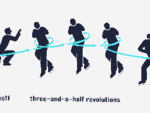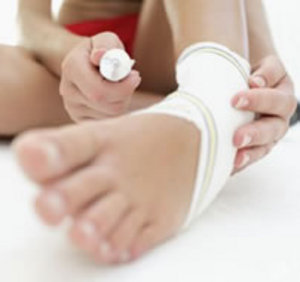Sports Injuries: Ankle and Wrist Injuries and Exercises
Poor flexibility and weakness in the ankles and wrists can lead to pain and serious injury. Injuries to the ankles and wrists can often be prevented with proper conditioning. According to Dr Mathew Hoffman, the most common sports injury is the sprained ankle. It is among the top ten in numerous articles.
The ankle is often injured by rolling it out or in. That may result in a sprain, strain, or fracture. A sprain is a stretching or tearing of the ligament. A complete rupture (tear) of a ligament can lead to surgery and a long rehabilitation time. A strain is a stretching or tearing of the muscle. And a fracture is the breaking of the bone. There are several types of fractures.
An injury which is common in gymnastics is landing “short,” the athlete’s ankle is flexed beyond their normal range of motion. If the ankles are flexible there may be very little damage, but if the athlete’s ankles are not flexible enough during a short landing the injury may be severe. With awareness of foot placement upon landing and ankle strength, this injury may be prevented or minimized.
One of the best ankle exercises is the Ankle Drill because it gently stretches the muscles before the contraction. It also involves both of the posterior muscles, gastrocnemius and soleus. The athlete will stand with their feet together and bend their knees until they feel a stretch in the Achilles tendon. Make sure the athlete bends at the hips too. Once they feel the stretch, your athlete will keep their knees bent and lift their heels pressing them forward. This position is called the forced arch of the ankle. After this forced arch position the athlete will straighten the knees, remaining on the toes briefly. The athlete should return to the standing position. The ankle drill is very useful for flexibility and strength.
The Seated Calf Raise with dumbbells is another useful ankle exercise. The athlete will sit in an upright position with the knees placed at 90 degrees. Their knees should be directly over their ankles, knees bent at 90°. Once in position, the athlete will place a dumbbell on top of each thigh just behind their knees. Instruct them to raise their heels up by pushing off the balls of feet. The athlete will lift and lower their heels to exercise the lower leg muscles. Remind your athlete to sit upright with their back and head in a neutral position.
Another useful ankle exercise is the Ankle Alphabet. Ask your athlete to sit on the floor with their legs stretched out in front. Ask the athlete to write the Alphabet with their toes. This will help with range of motion and a little strength.
With regard to the wrists, an overuse injury such as tendonitis is common. That too can be prevented or minimized with rest, ice, and proper conditioning. Did you know that there is often an imbalance with the muscles in the forearm? The muscles that flex the wrist are often stronger than the muscles that extend the wrist.
One exercise to correct the imbalance is the wrist curl and extension with a light dumbbell. Your athlete should sit with their forearms resting on their thighs. Instruct them to make their palms face down. Once in that position ask your athlete to curl the dumbbell up towards the ceiling. Make sure they have a good grip on the weight. Next, instruct your athlete to begin the exercise with their palms facing up.
I also like the Towel Forearm Curl (Wring the Towel). Your athlete should start standing up straight and holding a towel in their hands. They should pretend to wring a towel dry, 10-15 times. They will move their hands simultaneously, but in opposite directions. The athlete will switch the direction in which their hands are wringing the towel for each repetition.
Another useful exercise for the lower arm and wrist is Supination and Pronation with a fitness band. Secure a resistance band on a stable object such as the base of fitness or gymnastics equipment. Instruct your athlete to stand with their left side facing the base of the equipment. Wrap the band around your hand. Your athlete should bend their elbow to 90 degrees, keeping the upper arm against their body. Have the athlete slowly rotate their forearm (supinate) against the resistance band so your palm faces up. Perform 10-15 reps. Have the athlete turn around so that their right side is facing the equipment. Tell them to bend their arm, keeping the elbow at their side. Now your athlete will start with their palm facing up and rotate their hand (pronate) so that their palm faces the floor.
And an exercise that many think is only for the biceps will help with weakness in the wrists and forearm. The Reverse Biceps Curl with dumbbells is a great exercise. Your athlete will stand with their feet shoulder width apart and their knees relaxed. Instruct your athlete to hold one dumbbell (light weight) in each hand. They will start with the dumbbells resting on their thighs in front of their body. Instruct your athlete to slowly bring the dumbbells up towards their shoulders. As they lift and lower the dumbbells, their must palms face the floor. Remind your athlete to keep their elbows on their torso. Do not allow your athlete to lean back.
Remember that you must stop your athlete form performing any skill or exercise if they feel pain. Pain is a sign of injury. The injury must be checked by a medical doctor. Only allow your athlete to perform these exercises if they are not injured or have medical clearance to return to training.
By Karen Goeller, CSCS







